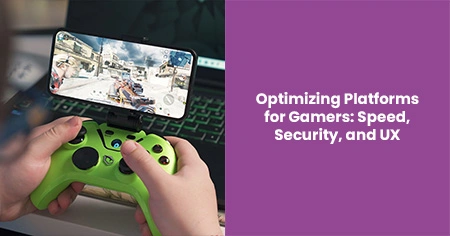That trust goes deeper than speed. It rests on knowing an account is safe and progress will stay where it belongs. The right platform makes this second nature, so no one has to worry about a password or a lost level.
Speed, security, and ease of use form a quiet promise. They work together. They shape how long a player stays, how deep they sink into a match, and how often they come back for more.
Understanding Gamer Expectations
Gamers arrive with sharp instincts and little patience for delays. They expect platforms that move as quickly as their hands, servers that stay stable under pressure, and controls that feel like a natural extension of their thoughts. Anything less can ruin the moment and send them elsewhere.
Here are the core demands every gamer brings to the table:
- Low Latency Connections: No one wants delays that cause missed shots or broken combos. Every millisecond counts when victory is on the line.
- Smooth Multiplayer Experiences: Matches must stay fluid and stable, regardless of how many people join. Sudden disconnects or stuttering kill the thrill of a close game.
- Consistent Performance Across Devices: Players shift between screens, from console to phone to laptop. The best platforms remember settings, save progress, and deliver the same experience every time.
- Highly Customizable Interfaces: A rigid layout can frustrate even the best player. The best platforms invite people to adjust controls, shortcuts, and settings until they suit their style and needs.
Speed as the Heart of Engagement
Speed decides how long a gamer stays in a match. A slow load, a stutter, or a long wait can kill the mood. The best platforms respect every second, knowing that seamless play creates trust and sparks loyalty.
The Cost of Lag
Delays frustrate players. A slight stutter can ruin a well‑timed attack. Longer load screens test patience and drive people away. Every moment spent staring at a spinner is a moment closer to a player clicking ‘exit’ and moving on.
Techniques to Minimize Lag
Smart platforms solve this problem at its root through the following:
- Edge Servers and Content Delivery Networks (CDNs): Bring data closer to the player, making every action load faster.
- Optimized Code: Reduce clutter and redundant requests to shave seconds off load times.
- Lightweight Design: Minimize files and compress assets so pages open in an instant.
Getting Back in Action Quickly
Sometimes, long grinds and low in‑game levels can kill the thrill. Players want access to rare items, higher ranks, and special mods that can take days or weeks to unlock. Services like U7BUY give them a chance to skip the wait. By starting with a premium GTA 5 account, gamers can spend less time repeating early missions and more time enjoying the action. This is how platforms can support their players and keep them engaged from the very first click.
Security as the Shield Against Threats
A gamer’s trust rests on one thing: knowing their hard work is safe. An online match can shift in seconds when bad actors slip in. A single breach can ruin countless hours of effort and send a player elsewhere. That’s why security forms the backbone of every successful platform.
Common Challenges
Modern gaming platforms face constant threats.
- DDoS Attacks: Flood servers with traffic until they crash, making matches unplayable and causing downtime that frustrates communities.
- Account Compromises and Cheating: Bad actors gain access to accounts, steal items, or manipulate rankings. This ruins competitive balance and damages trust.
- Phishing and Social Engineering: Fake messages or websites trick players into sharing their login details, making it easy for hackers to hijack accounts.
- Malware and Bots: Scripts and bots bypass fair play, creating unfair matches, crashing servers, or extracting sensitive user data.
Best Practices for Stronger Defenses
Modern platforms invest in protection, including the following:
- Two‑Factor Authentication (2FA): Requires an extra step to log in, making it harder for hackers to gain access.
- End‑to‑End Encryption: Secures data between servers and devices so that sensitive information never falls into the wrong hands.
- Advanced Anti‑Cheat algorithms: Monitor activity in real‑time, spot unfair behavior, and remove cheaters before they ruin the experience.
Why It Matters
A secure environment gives players the confidence to stay, spend, and compete. It means knowing every match is fair and every win is earned. Strong security protects data. It also strengthens communities, encourages loyalty, and allows platforms to evolve across consoles, mobile, and PC.
In a world where attacks evolve every day, making security a priority is the best way to protect trust and build a reputation that lasts. That is how platforms win respect and loyalty. They do it by showing every gamer that their time, their victories, and their identity matter every moment they play.
Designing an Exceptional User Experience
An intuitive user experience respects a gamer’s time and energy. It removes confusion, reduces friction, and guides the player from one moment to the next. The best platforms make this seamless. They invite people to stay longer, play harder, and return often.
Must‑Have UX Features
The best platforms remove friction and guide a gamer naturally. They focus on making every click, screen, and alert feel like it belongs. Here are the core features that define this experience:
- Intuitive Navigation: Clear menus, simple settings, and visible prompts help a player focus on the game rather than searching for controls.
- Clear Feedback and Error Handling: Messages that make sense and guide the user when things go wrong build trust and reduce frustration.
- Consistent Experience Across Platforms: The layout, settings, and feel of the game must remain familiar whether a player switches from a console to a phone or laptop.
User‑Centered Design Practices
- A/B testing Layouts: Try different menu arrangements, button sizes, and icon positions to find the best fit for actual gamer behavior.
- Gathering Gamer Feedback and Iterating Quickly: Listen to reviews, watch how people play, and adjust the design every step of the way.
- Prioritizing Accessibility Settings: Offer adjustable text sizes, color‑blind modes, and custom controls so every gamer can play comfortably regardless of ability.
Results of Strong UX
A clean, well‑tested design encourages longer sessions. It turns first‑time visitors into loyal customers. It creates trust when every screen, every button, every alert works like it should. The payoff goes beyond a single match.
Players notice platforms that respect their habits and anticipate their needs. They spend more time, invite friends, and attach themselves to brands that listen and evolve. Strong UX doesn’t only smooth out the path. It builds a space where people want to stay.
Improving Resource Management for Gaming
Modern platforms must balance performance with efficiency. Every frame rendered, every packet sent, impacts how a match feels. Smart resource management makes this balance possible.
- Dynamic Resource Allocation: Systems adjust frame rates and graphics settings in real time based on load, keeping play smooth regardless of hardware constraints.
- Smart Bandwidth Distribution: Prioritize critical data so inputs and on‑screen events arrive first, making every moment crisp and responsive.
- Intelligent load-balancing across servers: Distributing traffic evenly prevents bottlenecks and reduces downtime when servers experience high activity.
Better resource allocation delivers noticeable benefits. It reduces crashes caused by overloaded servers and trims load delays that frustrate dedicated players. Most of all, it creates smoother multiplayer interactions that feel fair and fluid.
Ensuring Seamless Updates Without Disruption
Players expect new maps, modes, and fixes. They also expect to stay in the game while changes happen. Smart platforms make this possible.
- Phased Deployments: Release updates to smaller groups first, fixing errors before reaching the whole player base.
- Beta Testing and User Acceptance: Let dedicated gamers try new features early, providing valuable feedback before launch.
- Automated Background Updates: Push files quietly while people play, reducing wait times and making changes feel natural.
These methods build trust. They reduce downtime that can frustrate regulars and minimize interruptions for avid players. By making updates seamless, platforms keep their audience engaged and invested long after the initial launch.
Monitoring and Analyzing User Sessions
Data tells a story every gamer can relate to. Understanding how and when people play guides future design choices and prioritizes improvements that matter.
- Session Length and Drop‑off Points: Pinpoint moments when engagement wanes and adjust content or design accordingly.
- Ping Times and Connection Stability: Measure performance across servers and platforms to spot bottlenecks quickly.
- User Engagement Across Platforms: Compare behavior across consoles, mobile devices, and PCs to identify patterns and optimize the experience.
These insights drive quick fixes and long‑term planning. They help platforms evolve with their audience, making every session smoother, every match fairer, and every click more rewarding.
Wrapping Up
A strong platform respects every second a gamer spends online. It delivers crisp performance, shields accounts from threats, and guides people with a design that feels like a natural fit.
The best platforms evolve with their audience, fine‑tuning every click and every frame until the experience disappears and only the game shines. In that space, trust grows. Players stay longer. They invite friends. They build memories.








